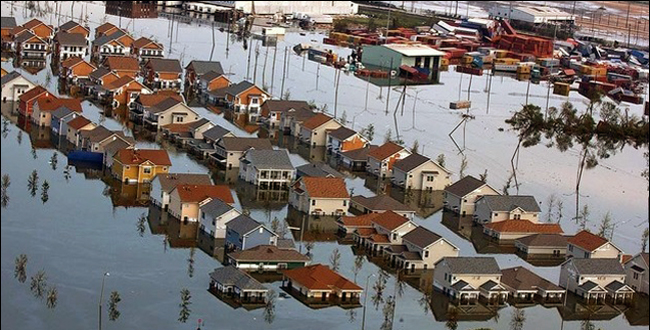- Written by Jennifer King
- Category: Media Releases
We are helping the NWS spread the word about Hurricane Preparedness Week (May 6-12, 2018) on social media!
Everyone is welcome to use the text and images provided below to help the NWS build a Weather-Ready Nation.
Sunday, May 6th
Facebook
Hurricanes are not just a coastal problem. Their impacts can be felt hundreds of miles inland, and significant impacts can occur without it being a major hurricane. Hurricane Preparedness Week (May 6-12, 2018) is your time to prepare for a potential land-falling tropical storm or hurricane.
http://weather.gov/hurricanesafety
Twitter
Hurricane Preparedness Week (May 6-12, 2018) is your time to prepare for a hurricane.
http://weather.gov/hurricanesafety #HurricanePrep #HurricaneStrong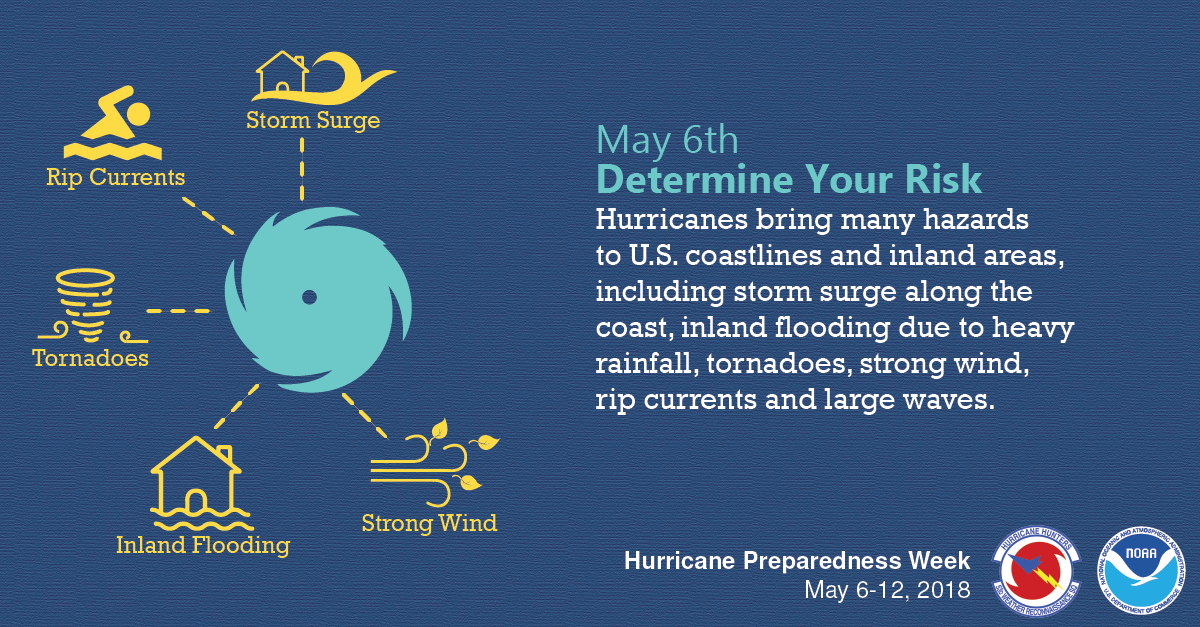
Monday, May 7th
Facebook
During Hurricane Preparedness Week, make sure you have a hurricane evacuation plan. The first thing you need to do is find out if you live in a storm surge hurricane evacuation zone or if you’re in a home that would be unsafe during a hurricane. If you are, figure out where you’d go and how you’d get there if told to evacuate. You do not need to travel hundreds of miles. Identify someone, perhaps a friend or relative who doesn’t live in an evacuation zone or unsafe home, and coordinate with them to use their home as your evacuation destination. Be sure to account for your pets, as most local shelters do not permit them. Put the plan in writing for you and those you care about.
http://flash.org/hurricane-season/evacuation-zones/find-your-evacuation-zones.pdf
Twitter
Are you in a hurricane evacuation zone?
http://flash.org/hurricane-season/evacuation-zones/find-your-evacuation-zones.pdf #HurricanePrep #HurricaneStrong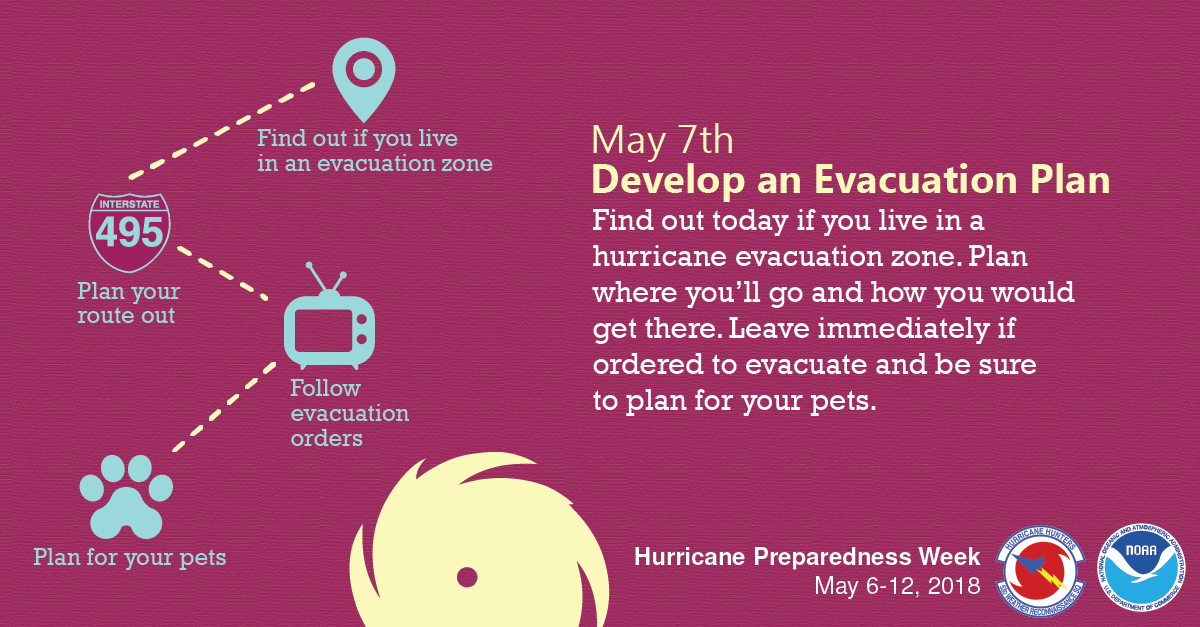
Tuesday, May 8th
Facebook
If a hurricane strikes, you’re going to need supplies not just to get through the storm but for the potentially lengthy recovery period that could follow. Have enough non-perishable food, water and medicine to last each person in your family a minimum of one week. Electricity and water could be out for at least that long. You’ll need extra cash, a battery-powered radio and flashlights. You’ll also need a portable crank or solar powered USB charger to charge your cell phone.
Twitter
What should be in your hurricane kit? https://www.ready.gov/kit #HurricanePrep #HurricaneStrong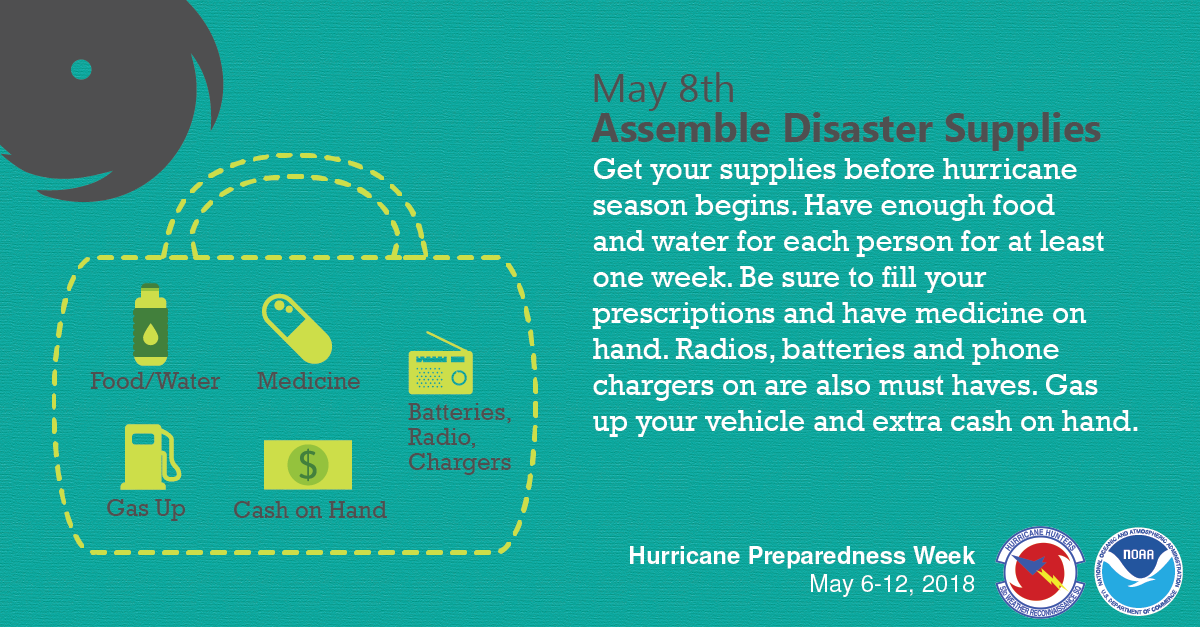
Wednesday, May 9th
Facebook
This Hurricane Preparedness Week, call your insurance company or agent and ask for an insurance checkup to make sure you have enough homeowners insurance to repair or even replace your home. Don’t forget coverage for your car or boat. Remember, standard homeowners insurance doesn’t cover flooding. Whether you’re a homeowner or renter, you’ll need a separate policy for flooding. It’s available through your company, agent or use the agent locator at www.floodsmart.gov. Act now as flood insurance requires a 30-day waiting period.
https://www.fema.gov/what-mitigation
Twitter
Are you insured for a hurricane? Find coverage at www.floodsmart.gov #HurricanePrep #HurricaneStrong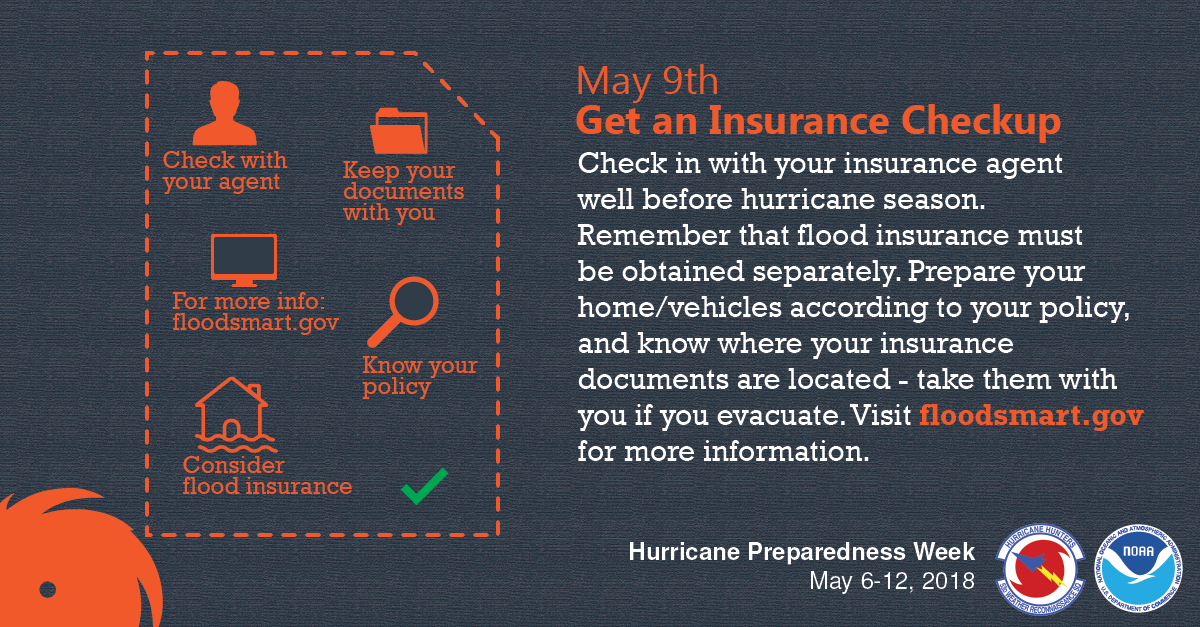
Thursday, May 10th
Facebook
If you plan to ride out a hurricane in your home, make sure it is in good repair and up to local hurricane building code specifications. Have the proper plywood, steel or aluminum panels to board up the windows and doors. Remember, the garage door is the most vulnerable part of the home, so it must be able to withstand high winds.
https://www.fema.gov/what-mitigation
Twitter
Can your home withstand a hurricane? https://www.fema.gov/what-mitigation #HurricanePrep #HurricaneStrong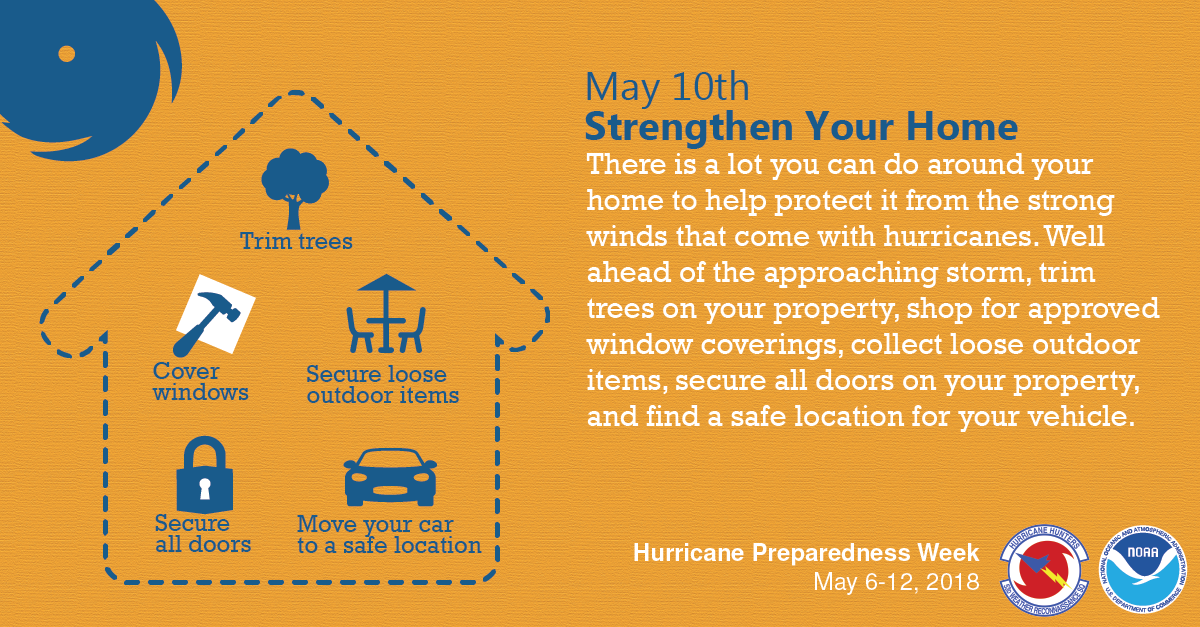
Friday, May 11th
Facebook
Many Americans rely on their neighbors after a disaster, but there are also many ways you can help your neighbors before a hurricane approaches. Learn about all the different actions you and your neighbors can take to prepare and recover from the hazards associated with hurricanes: https://community.fema.gov/action/plan-with-neighbors
Twitter
You can play a large role in how your neighbors fare before, during and after a hurricane. https://community.fema.gov/action/plan-with-neighbors #HurricanePrep #HurricaneStrong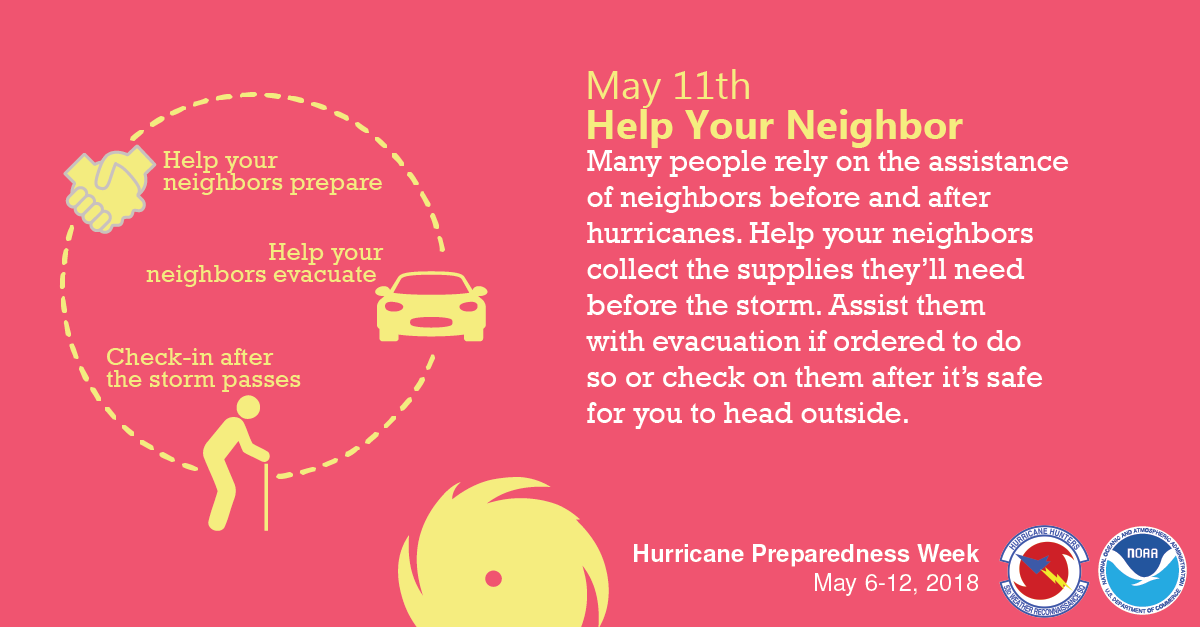
Saturday, May 12th
Facebook
The time to prepare for a hurricane is before the season begins, when you have the time and are not under pressure. If you wait until a hurricane is on your doorstep, the odds are that you will be under duress and will make the wrong decisions. Take the time now to write down your hurricane plan. Know where you will ride out the storm and get your supplies now. You don’t want to be standing in long lines when a Hurricane Watch is issued. Those supplies that you need will probably be sold out by the time you reach the front of the line. Being prepared, before a hurricane threatens, makes you resilient to the hurricane impacts of wind and water. It will mean the difference between your being a hurricane victim and a hurricane survivor.
https://www.ready.gov/make-a-plan
Twitter
Make a plan - before hurricane season begins. https://www.ready.gov/make-a-plan #HurricanePrep #HurricaneStrong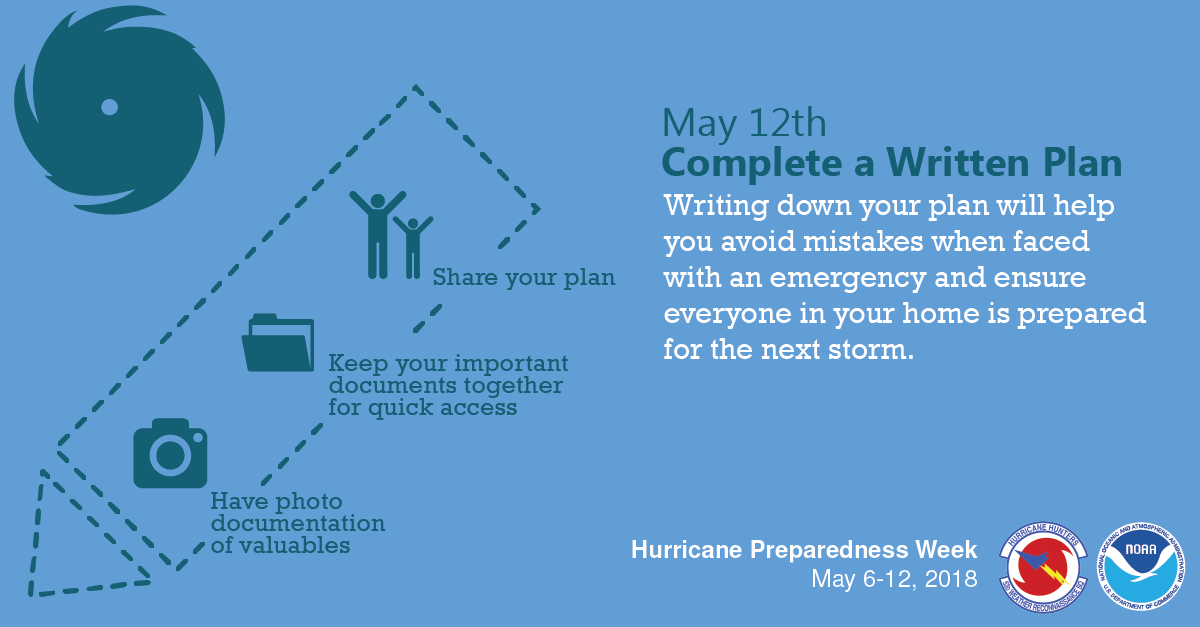
Videos
Facebook
Learn the dangers of a hurricane storm surge with this fast draw video. Storm surge is what officials use when determining who to evacuate. Remember, when officials say it is time to evacuate... go! http://youtu.be/bBa9bVYKLP0
Twitter
Storm surge is dangerous! Remember, when officials say it is time to evacuate... go! https://youtu.be/bBa9bVYKLP0 #HurricanePrep #HurricaneStrong
Hurricanes.gov/prepare
Facebook
Facebook It only takes one storm to change your life and community. Tropical cyclones are among nature’s most powerful and destructive phenomena. If you live in an area prone to tropical cyclones, you need to be prepared. Learn how during Hurricane Preparedness Week (May 6-12, 2018). http://hurricanes.gov/prepare
Twitter
Hurricane Preparedness Week (May 6-12) is your time to prepare for hurricanes. http://hurricanes.gov/prepare #HurricanePrep #HurricaneStrong
Facebook
Hurricane Preparedness Week (May 6-12, 2018) is your time to prepare for a potential land-falling tropical storm or hurricane. Learn how with daily tips and related links. Share these with your friends and family to ensure that they're prepared. http://hurricanes.gov/prepare
Learn how to prepare for hurricanes with daily tips and more. http://hurricanes.gov/prepare #HurricanePrep #HurricaneStrong
weather.gov/hurricanesafety
Facebook
Remember, it only takes one storm to change your life and community. For more information on hurricanes and hurricane safety, visit weather.gov/hurricanesafety
Twitter
It only takes one storm to change your life & community! Prepare! weather.gov/hurricanesafety #HurricaneSafety #ItOnlyTakesOne
- Hits: 2688
- Written by Jennifer King
- Category: Media Releases
From the Centers for Disease Control and Prevention (CDC)

 The CDC launched the “Clean Hands Count” campaign in 2016 to urge healthcare professionals, patients, and patients’ loved ones to prevent healthcare-associated infections by keeping their hands clean.
The CDC launched the “Clean Hands Count” campaign in 2016 to urge healthcare professionals, patients, and patients’ loved ones to prevent healthcare-associated infections by keeping their hands clean.
Although hand contact is known to be a major way germs spread in medical facilities, studies show that some healthcare professionals don’t follow CDC hand hygiene recommendations. On average, healthcare professionals clean their hands less than half of the times they should.
“Patients depend on their medical team to help them get well, and the first step is making sure healthcare professionals aren’t exposing them to new infections,” said CDC Director Tom Frieden, M.D., M.P.H. “Clean hands really do count and in some cases can be a matter of life and death.”
Part of the new campaign promotes healthcare provider adherence to CDC hand hygiene recommendations by addressing some of the myths and misperceptions about hand hygiene. For example, some people wrongly believe that using alcohol-based hand sanitizer contributes to antibiotic resistance and that it is more damaging to hands than washing with soap and water. Alcohol-based hand sanitizer kills germs quickly and in a different way than antibiotics, so it does not cause antibiotic resistance, and it causes less skin irritation than frequent use of soap and water.
The initiative also encourages patients and their loved ones to ask their healthcare team to clean their hands if they don’t see them do so before providing care.
“We know that patients can feel hesitant to speak up, but they are important members of the health care team and should expect clean hands from providers,” said Arjun Srinivasan, M.D., CDC’s associate director for healthcare-associated infection prevention programs. “We know that healthcare providers want the best for their patients, so we want to remind them that the simple step of cleaning their hands protects their patients.”
An estimated 722,000 healthcare-associated infections occur each year in U.S. hospitals, and about 75,000 patients with these infections die during their hospital stays. Healthcare providers should follow good hand hygiene practices, such as cleaning their hands before and after every patient contact. CDC’s new campaign uses dramatic images and messages to catch doctors’ and nurses’ attention, dispel myths about hand hygiene, and empower patients to advocate for clean hands.
For more information and examples of campaign materials visit: www.cdc.gov/handhygiene.
- Hits: 2417
- Written by Jennifer King
- Category: Media Releases
From the Centers for Disease Control and Prevention (CDC)
5 Surprising Facts About High Blood Pressure
 What you don’t know about high blood pressure could hurt you. High blood pressure affects one in three Americans,1 yet many people with the condition don’t know they have it.
What you don’t know about high blood pressure could hurt you. High blood pressure affects one in three Americans,1 yet many people with the condition don’t know they have it.
Uncontrolled high blood pressure raises the risk for heart disease and stroke, which are leading causes of death in the United States. Fortunately, high blood pressure is treatable and preventable. To lower your risk, get your blood pressure checked regularly and take action to control your blood pressure if it is too high.
Contact your local Public Health Department in Cherokee, Fannin, Gilmer, Murray, Pickens or Whitfield County for blood pressure screening and high blood pressure prevention information.... click on the above LOCATIONS tab to find them!
1. High blood pressure may be linked to dementia.
Recent studies show that high blood pressure is linked to a higher risk for dementia, a loss of cognitive function.2 Timing seems to matter: Some evidence suggests having uncontrolled high blood pressure during midlife (age 45 to 65) creates a higher risk for dementia later in life.3 The takeaway? It’s never too early to start thinking about your blood pressure and taking steps to manage it.
Mind Your Risks, a campaign from the National Institute of Neurological Disorders and Stroke, is educating people about the importance of controlling high blood pressure in midlife.
2. Young people can have high blood pressure, too.
High blood pressure doesn’t just happen to older adults. About one in four men and nearly one in five women age 35 to 44 has high blood pressure.4
High blood pressure is a leading cause of stroke, a condition that is on the rise among younger people. Experts think the increased risk for stroke among young adults is a direct result of the rising rates of obesity, high blood pressure, and diabetes—conditions that are preventable and treatable.
Younger people should get their blood pressure checked at least once each year. You can get your blood pressure checked at a doctor’s office, a pharmacy, or at many grocery stores.

Many people with high blood pressure don’t even know they have it. The only way to know is to check your blood pressure regularly.
3. High blood pressure usually doesn’t have any symptoms.
High blood pressure is sometimes called the “silent killer.” Most people with high blood pressure don’t have any symptoms, such as sweating or headaches. Because many people feel fine, they don’t think they need to get their blood pressure checked. Even if you feel normal, your health may be at risk. Talk to your doctor about your risk for high blood pressure.
4. Many people who have high blood pressure don’t know it.
About 11 million U.S. adults with high blood pressure aren’t even aware they have it and are not receiving treatment to control their blood pressure.1Most people with uncontrolled blood pressure have health insurance and visit a health care provider at least twice a year, but the condition remains undiagnosed, hidden from the doctor and patient.5 CDC is working with providers to find patients with high blood pressure who are ” hiding in plain sight.” Ask your provider what your blood pressure numbers mean and whether they are too high. Stick to your treatment plan and follow your provider’s advice if you are diagnosed with high blood pressure.
What You Can Do By living a healthy lifestyle, you can help keep your blood pressure in a healthy range and lower your risk for heart disease and stroke. A healthy lifestyle includes
- Eating a healthy diet
- Maintaining a healthy weight
- Getting enough physical activity
- Not smoking
- Limiting alcohol use Learn more about steps you can take to prevent high blood pressure.
5. Women and minorities face unique risks when it comes to high blood pressure.
Women with high blood pressure who become pregnant are more likely to have complications during pregnancy than those with normal blood pressure. High blood pressure can harm a mother’s kidneys and other organs, and it can cause low birth weight and early delivery. Certain types of birth control can also raise a woman’s risk for high blood pressure. Women with high blood pressure who want to become pregnant should work with their health care team to lower their blood pressure before becoming pregnant.
African American men and women have higher rates of high blood pressure than any other race or ethnic group.4 These individuals are also more likely to be hospitalized for high blood pressure. Experts think this is related to higher rates of obesity, diabetes, and stroke among this group. Lifestyle changes, such as reducing sodium in your diet, getting more physical activity, and reducing stress, can help lower blood pressure (see sidebar).
What CDC Is Doing
CDC supports several public health efforts that address high blood pressure, including:
- Million Hearts®. Uncontrolled high blood pressure is a leading cause of heart disease and stroke. Million Hearts® is a national initiative with a goal to prevent 1 million heart attacks and strokes. CDC and the Centers for Medicare & Medicaid Services co-lead the initiative on behalf of the U.S. Department of Health and Human Services. Million Hearts® provides toolkits for health care practitioners to help them find patients with undiagnosed high blood pressure and provide consistent, effective treatment for the condition.
- WISEWOMAN (Well-Integrated Screening and Evaluation for WOMen Across the Nation). The WISEWOMAN program provides low-income, under-insured, or uninsured women with chronic disease screenings, lifestyle programs, and referral services to prevent heart disease and stroke. CDC currently funds 21 WISEWOMAN programs, which operate on the local level in states and tribal organizations.
- Sodium Reduction in Communities Program (SRCP). A diet too high in sodium is associated with higher blood pressure. SRCP aims to increase access to lower sodium food options and reduce the amount of sodium Americans eat and drink each day. CDC currently funds 6 local communities and 4 state-level programs to carry out this work.
References
- NHANES 2013-2014 unpublished estimates. CDC/DHDSP Million Hearts Hypertension tracking.
- Attems, J & Jellinger, KA (2014). The overlap between vascular disease and Alzheimer’s disease – lessons from pathology. BMC Medicine; 12: 206.
- Muller, M, Sigurdsson, S, Kjartansson, O, Aspelund, T, Lopez, OL, Jonnson, PV, et al. (2014). Joint effect of mid- and late-life blood pressure on the brain: The AGES-Reykjavik Study. Neurology; 82(24): 2187–2195.
- Centers for Disease Control and Prevention. (2014). Power Down in May for National High Blood Pressure Education Month.
- Wall, HK, Hannan, JA and Wright, JS. (2014). Patients with undiagnosed hypertension: Hiding in plain sight. JAMA; 312(19):1973-1974.
More Information
More Information
- CDC – High Blood Pressure
- American Heart Association – High Blood Pressure
- National Heart, Lung, and Blood Institute – High Blood Pressure
- Hits: 2450
- Written by Jennifer King
- Category: Media Releases
The month of May is designated as Hepatitis Awareness Month in the United States, and May 19th is Hepatitis Testing Day. During May, The North Georgia Health District is joining the CDC and public health partners as we work to shed light on this hidden epidemic by raising awareness of viral hepatitis and encouraging priority populations to get tested.
Contact your local county health department in North Georgia for testing -- click on the above LOCATIONS tab for your North Georgia public health department in either Cherokee, Fannin, Gilmer, Murray, Pickens or Whitfield County!
- Hits: 2066



